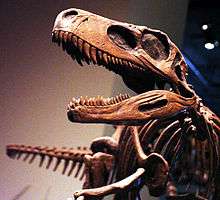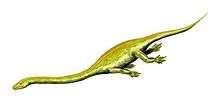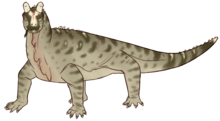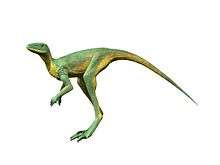Herrerasauridae
Herrerasauridae is a family of carnivorous basal saurischian dinosaurs. They are among the oldest known dinosaurs, first appearing in the fossil record around 233.23 million years ago (Late Triassic),[2] before becoming extinct by the end of the Triassic period. Herrerasaurids were relatively small-sized dinosaurs, normally not more than 4 metres (13 ft) long[3][4], although the holotype specimen of "Frenguellisaurus ischigualastensis" (nowadays considered a synonym of Herrerasaurus ischigualastensis) is thought to have reached around 6 meters (20 ft) long. The best known representatives of this group are from South America (Brazil, Argentina), where they were first discovered in the 1930s in relation to Staurikosaurus and 1960s in relation to Herrerasaurus. A nearly complete skeleton of Herrerasaurus ischigulastensis was discovered in the Ischigualasto Formation in San Juan, Argentina, in 1988. Less complete possible herrerasaurids have been found in North America, and they may have inhabited other continents as well.
| Herrerasauridae | |
|---|---|
 | |
| Mounted Herrerasaurus ischigualastensis skeleton cast, at the Field Museum of Natural History in Chicago. | |
| Scientific classification | |
| Kingdom: | Animalia |
| Phylum: | Chordata |
| Clade: | Dinosauria |
| Clade: | Saurischia |
| Family: | †Herrerasauridae Benedetto, 1973 |
| Genera[1] | |
| Synonyms | |
| |
Herrerasaurid anatomy is unusual and specialized, and they are not considered to be ancestral to any later dinosaur group. They only superficially resemble theropods and often present a mixture of very primitive and derived traits. The acetabulum is only partly open, and there are only two sacral vertebrae , the lowest number among dinosaurs. The pubic bone has a derived structure, being rotated somewhat posteriorly and folded to create a superficially tetanuran-like terminal expansion, especially prominent in H. ischigulastensis. The hand is primitive in having five metacarpals and the third finger longer than the second, but resembles those of theropods in having only three long fingers, with curved claws. Herrerasaurids also have a hinged mandible, which is also found in theropods.
Classification
It is not clear where Herrerasaurids lie on the early dinosaur evolutionary tree. They are possibly basal theropods or basal saurischians but may predate the saurischian-ornithischian split.[5] Early researchers even proposed that they represented an early lineage of sauropodomorphs. Some analyses, such as Nesbitt et al. 2009, have found Herrerasaurus and its relatives in Herrerasauridae to be very basal theropods,[6] while others (such as Ezcurra 2010) have found them to be basal to the clade Eusaurischia, that is, closer to the base of the saurischian tree than either theropods or sauropodomorphs, but not true members of either.[7] The situation is further complicated by uncertainties in correlating the ages of late Triassic beds bearing land animals.[3]
Other proposed members of the clade have included Sanjuansaurus[8] from the Ischigualasto Formation of Argentina, Staurikosaurus and Gnathovorax from the Santa Maria Formation of southern Brazil,[9] Chindesaurus from the Petrified Forest (Chinle Formation) of Arizona,[10] and possibly Caseosaurus from the Dockum Formation of Texas,[11][12] although the relationships of the North American animals are not fully understood, and not all paleontologists agree. Grzegorz Niedźwiedzki, Stephen L. Brusatte et al. (2014) described a European putative member of the group on the basis of Norian age fossils discovered in Poland.[13] Other possible basal saurischians include Alwalkeria from the Late Triassic Maleri Formation of southern India,[14] and Teyuwasu (recently considered synonym of Staurikosaurus)[15], known from very fragmentary remains from the Late Triassic of Brazil.[16]
The discovery of the Herrerasaurid Gnathovorax indicates that the family falls outside the Theropoda and Sauropodomorpha in the cladistic analysis undertaken on the genus when it was described, but remains squarely within Saurischia as basal members of the order.[17][18]
Phylogeny
Fernando Novas (1992) defined Herrerasauridae as Herrerasaurus, Staurikosaurus, and their most recent common ancestor.[19] Paul Sereno (1998) defined the group as the most inclusive clade including H. ischigualastensis but not Passer domesticus.[20] Langer (2004) provided first phylogenetic definition of a higher level taxon, Herrerasauria, as Herrerasaurus but not Liliensternus or Plateosaurus.[3] According to current phylogenetic studies, all of these definitions describe the same clade.
The first cladogram presented follows one proposed analysis by Novas et al. in May 2011. In this review, Herrerasaurus is found to be a basal saurischian, but not a theropod.[21] The second cladogram is based on an analysis by Sues et al. in April 2011. This review classified Herrerasaurus as a basal theropod.[22]
| Dinosauria |
| |||||||||||||||||||||||||||||||||||||||||||||
| Dinosauria |
| ||||||||||||||||||||||||||||||||||||||||||||||||
A large phylogenetic analysis of early dinosaurs by Matthew Baron, David Norman and Paul Barrett (2017) found Herrerasauridae within the clade Saurischia, as the sister group to Sauropodomorpha. This was the result of the removal of Theropoda from Saurischia and its placement next to Ornithischia within the newly created clade Ornithoscelida.[23]
| Dinosauria |
| ||||||||||||||||||||||||||||||||||||||||||||||||||||||||||||
Baron & Williams (2018) found Herrerasauria (including Saltopus and Caseosaurus) outside Dinosauria.[12] A similar result was provided by the phylogenetic analysis by Cau, 2018:[24]
| Dracohors |
| |||||||||||||||||||||||||||||||||||||||||||||||||||
References
- Holtz, Thomas R. Jr. (2012). "Winter 2011 Appendix" (PDF). Dinosaurs: The Most Complete, Up-to-Date Encyclopedia for Dinosaur Lovers of All Ages.
- Langer, M.C.; Ramezani, J.; Da Rosa, Á.A.S. (2018). "U-Pb age constraints on dinosaur rise from south Brazil". Gondwana Research. X (18): 133–140. Bibcode:2018GondR..57..133L. doi:10.1016/j.gr.2018.01.005.
- Langer, Max C. (2004). "Basal Saurischia". In Weishampel, David B.; Dodson, Peter; Osmólska, Halszka (eds.). The Dinosauria (2nd ed.). Berkeley: University of California Press. pp. 25–46. ISBN 978-0-520-24209-8. OCLC 55000644. OL 3305845M.
- Langer, Max C; Benton, Michael J. (2006). "Early dinosaurs: a phylogenetic study". Journal of Systematic Palaeontology. 4 (4): 309–358. doi:10.1017/S1477201906001970.
- Brinkman, Donald B.; Sues, Hans-Dieter (1987). "A staurikosaurid dinosaur from the Upper Triassic Ischigualasto Formation of Argentina and the relationships of the Staurikosauridae". Palaeontology. 30: 493–503.
- Nesbitt, Sterling J.; Smith, Nathan D.; Irmis, Randall B.; Turner, Alan H.; Downs, Alex & Norell, Mark A. (2009). "A complete skeleton of a Late Triassic saurischian and the early evolution of dinosaurs". Science. 326 (5959): 1530–1533. Bibcode:2009Sci...326.1530N. doi:10.1126/science.1180350. PMID 20007898.
- Ezcurra, Martin D. (2010). "A new early dinosaur (Saurischia: Sauropodomorpha) from the Late Triassic of Argentina: a reassessment of dinosaur origin and phylogeny". Journal of Systematic Palaeontology. 8 (3): 371–425. doi:10.1080/14772019.2010.484650.
- Alcober, Oscar A.; Martinez, Ricardo N. (2010). "A new herrerasaurid (Dinosauria, Saurischia) from the Upper Triassic Ischigualasto Formation of northwestern Argentina". ZooKeys (63): 55–81. doi:10.3897/zookeys.63.550. PMC 3088398. PMID 21594020.
- Colbert, E.H. (1970). "A saurischian dinosaur from the Triassic of Brazil". American Museum Novitates. 2405: 1–39.
- Long, R. A.; Murry, P. A. (1995). "Late Triassic (Carnian and Norian) Tetrapods from the Southwestern United States". Bulletin. New Mexico Museum of Natural History and Science. 4: 1–254.
- Hunt, Adrian P.; Lucas, Spencer G.; Heckert, Andrew B.; Sullivan, Robert M.; Lockley, Martin G. (1998). "Late Triassic Dinosaurs from the Western United States". Geobios. 31 (4): 511–531. doi:10.1016/S0016-6995(98)80123-X.
- Matthew G. Baron; Megan E. Williams (2018). "A re-evaluation of the enigmatic dinosauriform Caseosaurus crosbyensis from the Late Triassic of Texas, USA and its implications for early dinosaur evolution". Acta Palaeontologica Polonica. 63. doi:10.4202/app.00372.2017.
- Niedźwiedzki, Grzegorz; Brusatte, Stephen L.; Sulej, Tomasz; Butler, Richard J. (2014). "Basal dinosauriform and theropod dinosaurs from the mid–late Norian (Late Triassic) of Poland: implications for Triassic dinosaur evolution and distribution". Palaeontology. 57 (6): 1121–1142. doi:10.1111/pala.12107.
- Chatterjee, Sankar; Creisler, Benjamin S. (1994). "Alwalkeria (Theropoda) and Morturneria (Plesiosauria), new names for preoccupied Walkeria Chatterjee, 1987 and Turneria Chatterjee and Small, 1989". Journal of Vertebrate Paleontology. 14 (1): 142. doi:10.1080/02724634.1994.10011546.
- Garcia, Maurício S.; Müller, Rodrigo T.; Dias-Da-Silva, Sérgio (2019-07-04). "On the taxonomic status of Teyuwasu barberenai Kischlat, 1999 (Archosauria: Dinosauriformes), a challenging taxon from the Upper Triassic of southern Brazil". Zootaxa. 4629 (1): 146–150. doi:10.11646/zootaxa.4629.1.12. ISSN 1175-5334. PMID 31712541.
- Kischlat, E.-E. (1999). "A new dinosaurian "rescued" from the Brazilian Triassic: Teyuwasu barberenai, new taxon". Paleontologia Em Destaque, Boletim Informativo da Sociedade Brasileira de Paleontologia. 14 (26): 58.
- https://blogs.scientificamerican.com/laelaps/stunning-skeleton-reveals-early-carnivorous-dinosaur/
- https://peerj.com/articles/7963/
- Novas, F. E. (1992). "Phylogenetic relationships of the basal dinosaurs, the Herrerasauridae". Palaeontology. 35: 51–62.
- Sereno, P. C. (1998). "A rationale for phylogenetic definitions, with application to the higher-level taxonomy of Dinosauria". Neues Jahrbuch für Geologie und Paläontologie, Abhandlungen. 210 (1): 41–83. doi:10.1127/njgpa/210/1998/41.
- Novas, Fernando E.; Ezcurra, Martin D.; Chatterjee, Sankar; Kutty, T. S. (2011). "New dinosaur species from the Upper Triassic Upper Maleri and Lower Dharmaram formations of central India". Earth and Environmental Science Transactions of the Royal Society of Edinburgh. 101 (3–4): 333–349. doi:10.1017/S1755691011020093.
- Sues, Hans-Dieter; Nesbitt, Sterling J.; Berman, David S.; Henrici, Amy C. (2011). "A late-surviving basal theropod dinosaur from the latest Triassic of North America". Proceedings of the Royal Society B. 278 (1723): 3459–64. doi:10.1098/rspb.2011.0410. PMC 3177637. PMID 21490016.
- Baron, M.G.; Norman, D.B.; Barrett, P.M. (2017). "A new hypothesis of dinosaur relationships and early dinosaur evolution". Nature. 543: 501–506. Bibcode:2017Natur.543..501B. doi:10.1038/nature21700. PMID 28332513.
- Andrea Cau (2018). "The assembly of the avian body plan: a 160-million-year long process" (PDF). Bollettino della Società Paleontologica Italiana. 57 (1): 1–25. doi:10.4435/BSPI.2018.01.
- Agnolín, Federico L.; Rozadilla, Sebastián (2017). "Phylogenetic reassessment of Pisanosaurus mertii Casamiquela, 1967, a basal dinosauriform from the Late Triassic of Argentina". Journal of Systematic Palaeontology. 16 (10): 853–879. doi:10.1080/14772019.2017.1352623.
| Wikispecies has information related to Herrerasauridae |









